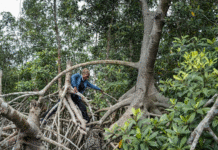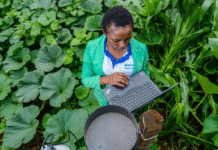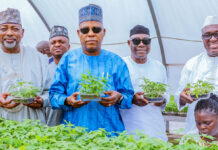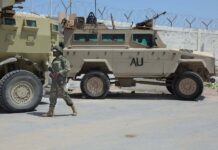Illustrative Image: Cholera Crisis in West and Central Africa: 80,000 Children at Risk Amid Deadly Outbreaks in 12 Countries
Image Source & Credit: WHO
Ownership and Usage Policy
An alarming surge in cholera outbreaks across West and Central Africa has put an estimated 80,000 children at immediate risk, according to UNICEF. As the region enters its rainy season, escalating floods and widespread displacement are creating the ideal conditions for cholera transmission—fuelling what could become one of the deadliest regional health crises in years.
Active cholera outbreaks in the Democratic Republic of the Congo (DRC) and Nigeria, the two most severely affected countries, have heightened the risk of cross-border infections. Additional outbreaks have been confirmed in Chad, Republic of Congo, Ghana, Côte d’Ivoire, and Togo, while Niger, Liberia, Benin, the Central African Republic, and Cameroon remain under close surveillance due to high vulnerability. The entire region is on alert as health systems are being stretched to their limits.
“Heavy rains, overflowing rivers, and mass displacement are intensifying cholera transmission risks and endangering the lives of children,” said Gilles Fagninou, UNICEF’s Regional Director for West and Central Africa. “The situation is urgent—without safe water, proper sanitation, and immediate medical intervention, children will continue to die. This is a survival emergency.”
Epicentre: Democratic Republic of the Congo
The DRC is currently the hardest-hit country. In July alone, the DRC’s Ministry of Health reported over 38,000 cholera cases and 951 deaths, with children under five representing more than a quarter (25.6%) of cases. Several provinces are in crisis—including South Kivu, North Kivu, Haut Katanga, Tshopo, Haut Lomami, Tanganyika, and Maniema—with forecasts suggesting this could be the worst outbreak since 2017 if containment efforts are not intensified.
The situation in Kinshasa, the capital, is particularly dire. Torrential rains and severe flooding have overwhelmed the city’s fragile infrastructure, leading to a rapid spike in cholera cases and a shocking case fatality rate of 8%. Healthcare systems are buckling under the pressure, struggling to cope with the growing influx of patients.
Cholera and Children: A Dangerous Mix
Children—especially those under five—are uniquely vulnerable to cholera due to several interrelated factors:
-
Weaker immune systems and greater risk of dehydration.
-
Inadequate access to clean drinking water and poor hygiene.
-
Malnutrition, which amplifies the risk of death from cholera.
In places like Chad, the crisis is being exacerbated by displacement. At the Dougui refugee site, about 103 km from Abéché and near the Sudanese border, 55 suspected cholera cases and four deaths have already been reported. Tests confirmed the presence of Vibrio cholerae in multiple samples. Most residents at this site are children living in overcrowded conditions with limited access to healthcare, potable water, and sanitation.
Nigeria and Beyond: The Widening Web of Infection
Nigeria, which has battled recurrent cholera outbreaks for years, has recorded 3,109 suspected cases and 86 deaths across 34 states as of June 2025. The country’s endemic vulnerability stems from weak water infrastructure, informal settlements, and frequent flooding.
Other nations are also struggling:
-
Ghana has reported 612 cases as of April 28.
-
Côte d’Ivoire has seen 322 cases and 15 deaths as of mid-July.
-
Togo recorded 209 cases and five deaths by late June.
While these figures may seem modest individually, taken together they point to a regional health emergency poised to grow worse without immediate intervention.
UNICEF’s Response and Urgent Appeal
Since the onset of the outbreaks, UNICEF has been actively responding by:
-
Delivering emergency health kits and WASH (Water, Sanitation, and Hygiene) supplies to communities and treatment centers.
-
Supporting targeted cholera vaccination campaigns in high-risk areas.
-
Promoting risk communication and community-based hygiene education.
-
Strengthening preparedness efforts in countries under threat.
However, the scale of the emergency demands more. UNICEF is urgently appealing for $20 million over the next three months to scale up life-saving interventions across affected and at-risk regions. These funds are critical to:
-
Equip health facilities.
-
Ensure clean water access.
-
Prevent transmission through community engagement and early warning systems.
“We are racing against time to prevent a full-blown disaster,” said Fagninou. “With our partners, we are extending our reach into underserved and remote areas—determined to protect every child from this preventable, treatable disease.”
The Bigger Picture: Cholera as a Development and Equity Crisis
Cholera is not just a health issue—it reflects broader systemic failures in water access, sanitation infrastructure, and public health systems. In regions where poverty, displacement, and climate extremes intersect, the disease thrives.
What is unfolding across West and Central Africa is both a humanitarian emergency and a development crisis—one that disproportionately endangers children. Ending cholera in the region will require not only emergency aid but also long-term investments in clean water systems, education, urban planning, and climate resilience.
The time to act is now. Without immediate support, thousands more children will suffer and die needlessly from a disease that is entirely preventable.
















 The African Research (AR) Index is a comprehensive scholarly directory and database focused explicitly on journal publishers that publish and disseminate African research.
The African Research (AR) Index is a comprehensive scholarly directory and database focused explicitly on journal publishers that publish and disseminate African research.

